Kookaburras, Kingfishers and Bee-eaters

THE LAUGHING KOOKABURRA
Kookaburra sits in the old gum tree,
Merry, merry king of the bush is he,
Laugh, Kookaburra, laugh, Kookaburra,
Gay your life must be!
So goes the verse that we both sang, in rounds, as children, growing up in Australia. Goodness only knows whether it is still sung or, indeed, whether that particular word in the final line is now considered ‘inappropriate’. The song, written by Marion Sinclair in 1932, and first performed at a Girl Guides meet in 1934, was sung in schools across the land and is even widely known the UK and the USA . In a recent footnote to that story, it was announced early in 2010 that Men at Work were being sued by the owners of the original song for infringing copyright by using a significant part of the melody in their famous song “Down Under”, itself considered an Australian classic.
The Emu may well be represented on the Australian Coat of Arms, but surely the Laughing Kookaburra is at least as well known and beloved, and equally representative of Australia. The Kookaburra is also called the Bushman’s Clock, because its raucous laughter is considered the first bird call each morning and the last each night.
According to Aboriginal lore, the Kookaburra’s chorus each morning is a signal to the sky people to light the great fire that illuminates the sky and warms the earth. For the Kookaburra itself, the calls serve to advertise their territory to would be interlopers.
The name ‘Kookaburra’ comes from the Aboriginal Wiradjuri people, and conveys the sound made at the beginning of the laugh – koo ,koo, kook, kook … as it ascends into its loud mimicry of hysterical human laughter.
Despite being the largest member of the kingfisher family, the Laughing Kookaburra is mainly a woodland bird. It is often seen perched high up in a gum tree, using its keen eye to spot lizards, snakes or insects below, then pouncing to catch them with its considerable beak. To kill its prey it shakes its head vigorously, and bangs the prey against the ground or a tree. Click on the following links to watch two short videos we took of a Kookaburra using this very method to kill its meal, in Ravensbourne National Park in Queensland.
httpv://www.youtube.com/watch?v=-LhRayCasS8
httpv://www.youtube.com/watch?v=fh7qFN1AN7I
It is always a joy to hear and see a Kookaburra in the Australian bush although, unfortunately, they are now widely seen in the south-west of Western Australia, an area where they are not native. Some well-meaning person, no doubt with a love of this species, released them into that area and they are now seen in significant numbers. Their presence puts pressure on other, traditional species in the region.
As I wrote this post, I realized to my horror that I didn’t have a recording of the Kookaburra’s song! We hope to rectify that before long.
THE BLUE-WINGED KOOKABURRA
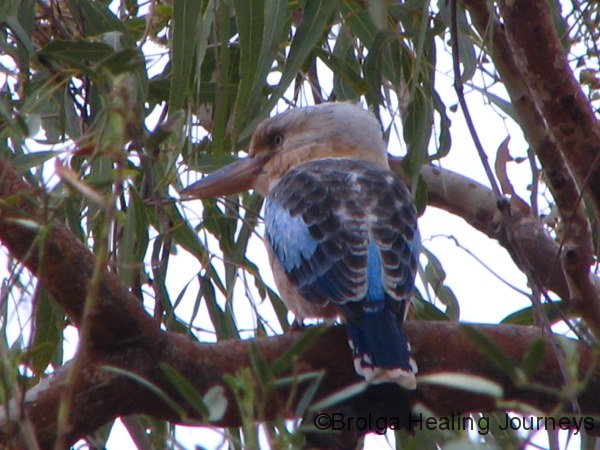
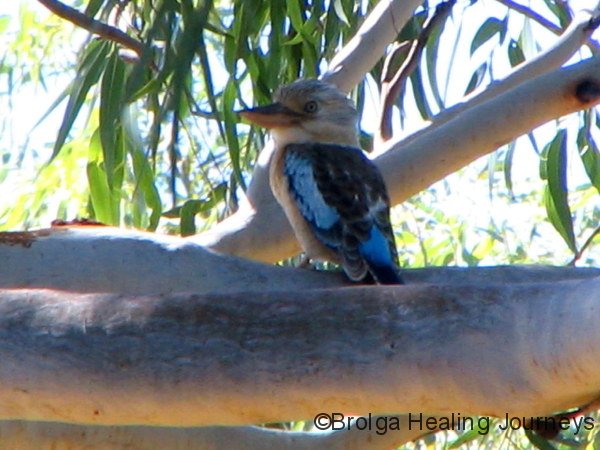
The Blue-Winged Kookaburra is somewhat smaller than its close Laughing relative, and is found across northern Australia and in the western Pilbara, where we had our first sighting of this attractive bird.
It shares many similarities in habitat and hunting with the Laughing Kookaburra, and in fact, in regions where the two species co-exist, they will actively exclude each other from their territories, as though they were of the same species.
The song of the Blue Winged Kookaburra doesn’t erupt into the full laughter of its more famous cousin, but is more a series of loud cackling coughs, almost as though it is trying to learn the full laughing call, but has not yet succeeded!
THE RED-BACKED KINGFISHER
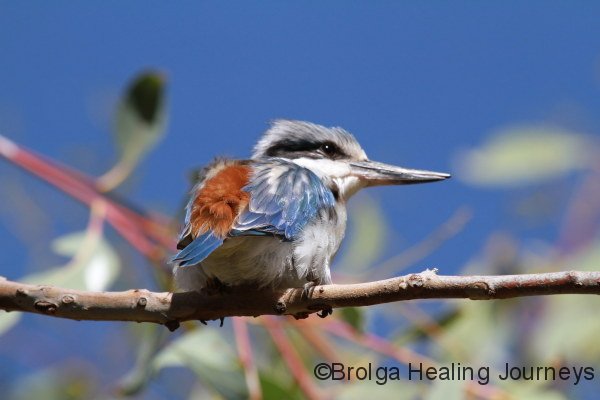
This beautiful bird has adapted well to the arid inland regions of Australia, often ranging far from water courses. They may well get sufficient water from their prey.
Their hunting techniques are similar to those of the Kookaburras – perch and pounce. Their diet consists mainly of insects, reptiles, frogs and even small birds.
THE SACRED KINGFISHER
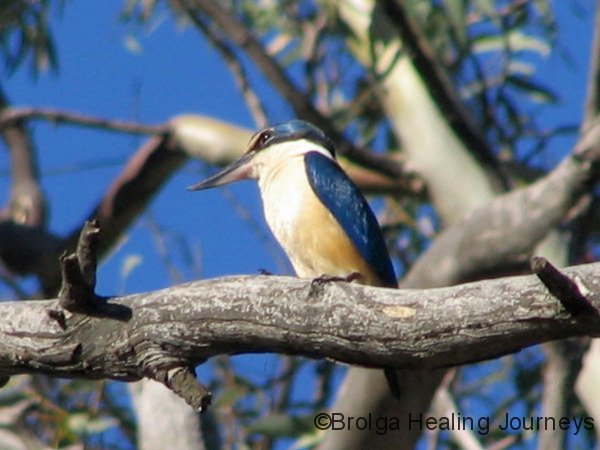
The Sacred Kingfisher is another widespread and well adapited member of the family. It can be seen in woodlands, where it lives on insects and reptiles, but also along streams, from which it catches fish.
THE AZURE KINGFISHER
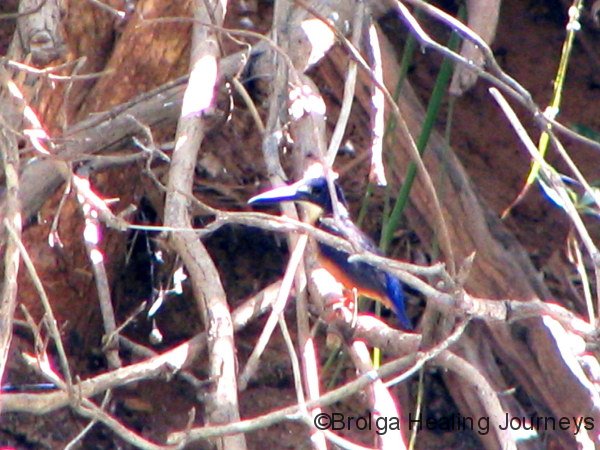
This beautiful little bird is found across the top of Australia and down the eastern seaboard. Unlike many other members of the family, it does most of its hunting along water courses, sitting on branches about 1 metre above the water, then pouncing to catch fish, crustaceans or water insects. It is a small kingfisher with a relatively huge beak; at first sight you get the impression that it is mostly beak with a small body attached!
Its rich colouring makes any sighting of this bird a true delight.
THE RAINBOW BEE-EATER
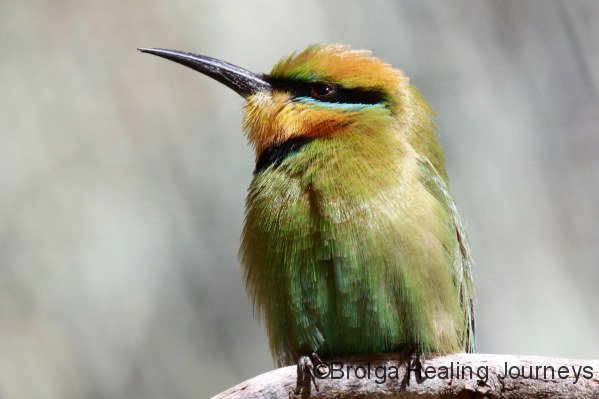
Although not formally considered members of the Kingfisher family, the Rainbow Bee-eater nonetheless resembles those birds in shape and is included in the same section of our various bird books, so it must come close!
It is a truly elegant bird in flight, catching all of its insect food on the wing. It swoops, glides and changes direction with ease as it chases bees, wasps and other flying insects. Our first sighting of the Rainbow Bee-eater was in 2002, in the Bungle Bungles, where we stood spell-bound for around 15 minutes watching as one bird flew out from its perch in a series of aerobatic displays as it caught a succession of flying insects.
In more recent times, as we travelled in Western Australia and the Northern Territory, we saw so many Rainbow Bee-eaters we almost grew blasé about them; but we have never tired of the sight of these colourful birds. Early each evening here in Alice Springs during the warmer months, we watched enthralled as a large flock of Rainbow Bee-eaters soared high above the gum trees in pursuit of their evening meal.




































I live in Townsville, Nth Qld and have never seen these birds, ‘Rainbow Bee-eater’, until yesterday. There were a few in our yard. They look absolutely beautiful. I also took quite a few pictures of them in our yard. Diane
Thanks for your comments Diane. The Rainbow Bee-eater is indeed a beautiful and elegant bird and we are glad you were lucky enough to have a few visit your yard!